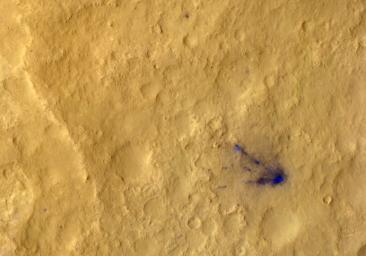
|
Dissecting the Scene of Sky Crane Crash
- Click the image above for a larger view
- Full-Res JPEG (2055 x 1437) (454.9 kB)
- Full-Res TIFF (2055 x 1437) (8.9 MB)
Caption:
After a rocket-powered descent stage, also known as the sky crane, delivered NASA's Curiosity rover to Mars on Aug. 5 PDT (Aug. 6 EDT), 2012, it flew away and fell to the surface. Possible multiple impacts from that collision are revealed in blue in this enhanced-color view taken by the High-Resolution Imaging Science Experiment (HiRISE) camera on NASA's Mars Reconnaissance Orbiter.
The main crash site is seen at right, shaped like a fan. Farther from the site are several smaller dark spots, which are thought to be secondary impacts from debris that continued to travel outward. The impact sites are darker because the lighter, reddish top layer of soil was disturbed, revealing darker basaltic sands underneath.
The full image for these observations can be seen at http://uahirise.org/releases/msl-tracks.php .
Background Info:
HiRISE is one of six instruments on NASA's Mars Reconnaissance Orbiter. The University of Arizona, Tucson, operates the orbiter's HiRISE camera, which was built by Ball Aerospace & Technologies Corp., Boulder, Colo. NASA's Jet Propulsion Laboratory, a division of the California Institute of Technology in Pasadena, manages the Mars Reconnaissance Orbiter Project for NASA's Science Mission Directorate, Washington. Lockheed Martin Space Systems, Denver, built the spacecraft.
Cataloging Keywords:
| Name | Value | Additional Values |
|---|---|---|
| Target | Mars | |
| System | ||
| Target Type | Planet | |
| Mission | Mars Science Laboratory (MSL) | Mars Reconnaissance Orbiter (MRO) |
| Instrument Host | Curiosity Rover | Mars Reconnaissance Orbiter |
| Host Type | Rover | Orbiter |
| Instrument | High Resolution Imaging Science Experiment (HiRISE) | |
| Detector | ||
| Extra Keywords | Atmosphere, Collision, Color, Impact, Storm | |
| Acquisition Date | ||
| Release Date | 2012-09-06 | |
| Date in Caption | ||
| Image Credit | NASA/JPL-Caltech/Univ. of Arizona | |
| Source | photojournal.jpl.nasa.gov/catalog/PIA16143 | |
| Identifier | PIA16143 | |
